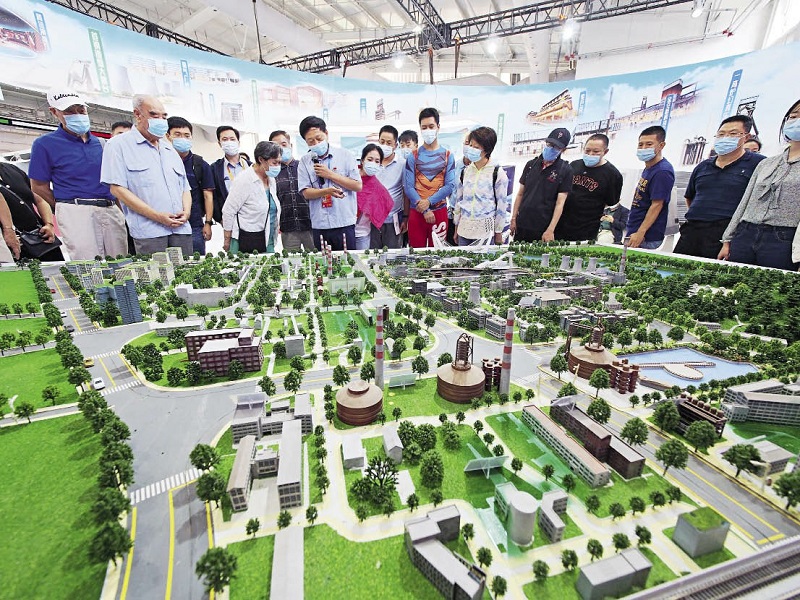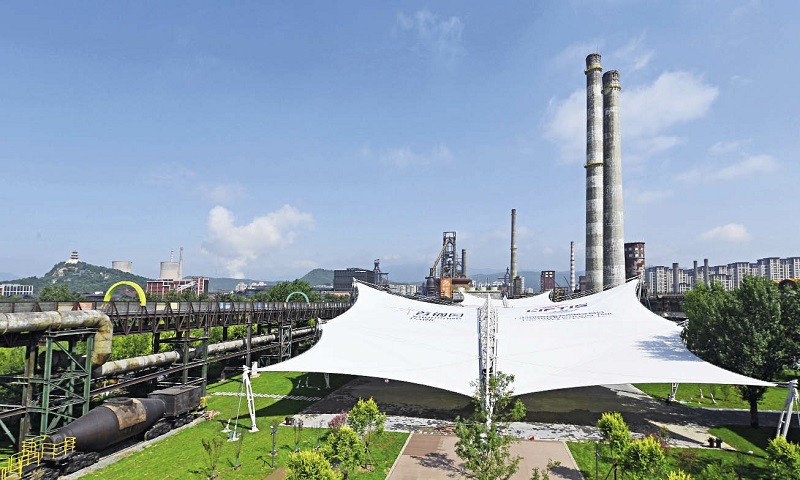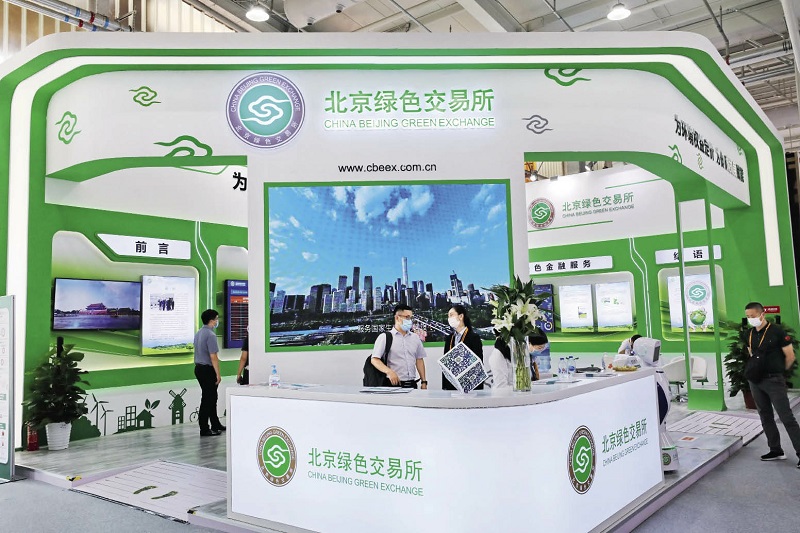At the China International Fair for Trade in Services (CIFTIS) held from September 2 to 7 in Beijing, elements of its vision “green, low-carbon, and environmental protection,” can be seen everywhere. In addition to 15 events advocating the vision, such as the “2021 International Summit on Green Development — Carbon Peak Carbon Neutral,” “Low-carbon Life, Waste-free City Construction,” and the “2021 China Carbon Neutral Development Forum,” the concept of green development was also reflected in various aspects, including the exhibition hall designs, booth construction, as well as products and innovative solutions on display.

Visitors examine a scale model of Shougang Park, one of the exhibition areas of the 2021 CIFTIS, on September 6, 2021.
Green Technology to Protect the Earth
Entering the exhibition hall at the China National Convention Center, the first thing that comes into vision is the Achievements Exhibition for China Trade in Services. It was a specially created “low-carbon and green” exhibition hall. According to the organizers, more than 90 percent of the building materials in the exhibition area are recyclable, and an immersive digital garden was created with natural landscaping techniques.
Since mobile phones are essential parts of modern life, a big question arises as to the proper disposal or recycling of these ubiquitous devices. Li Wenxiu, assistant to the secretary general of China Association of Trade in Services, has an answer. Standing amidst a well-designed virtual “rainforest” in the exhibition hall, and pointing to the electronic screen, she said, “Look, these two spider monkeys living in the Costa Rican rainforest are greeting the audience. This is a solar-powered rainforest monitoring system built by Huawei with recycled mobile phones, and technologies of artificial intelligence (AI) and the Internet of Things (IoT).”
She went on to describe how the recycled phones placed at the system’s various collection locations can capture a variety of audio data, such as the chirping of monkeys, the chainsaw sounds of timber theft and more, and transmit them in real time to an AI cloud server. If the system detects the sound of chainsaws, it will instantly activate an alarm and send the specific location positioning of the illegal loggers to local forest rangers. “The rainforests protected by the ‘Forest Keeper’ solution play a vital role in reducing carbon dioxide emissions and maintaining ecological balance globally,” Li said.
Jing’s Paper House, a time-honored paper-selling brand in Beijing, set up a booth at the CIFTIS. Jiang Xuejiao, design director of the brand, showed the audience a set of environmentally friendly stationery themed on Beijing Winter Olympics. The set had a Bing Dwen Dwen-themed notebook made of stone paper and a ballpoint pen made from recycled mineral water bottles.
“This notebook is made from the most common limestone. The waterproof and tear and insect-resistant paper is environmentally friendly as the entire production process doesn’t consume wood,” said Jiang. She explained that two discarded plastic bottles can be reused to make a ballpoint pen, and zipper bags are packed with biodegradable, safe, and non-toxic environmentally-friendly materials.
The Japanese company Epson has also come up with innovative green solutions. At the Green Future Lead with Innovation booth, the staff showed how recycled paper is processed into pieces by a shredder and then generated as recycled paper through three steps of fiber separation, strong bonding, and press molding. The whole process of producing a piece of recycled A4 paper takes only a minute.
Akihiro Fukaishi, president of Epson (China) Co., Ltd., said the company’s solution is called “PaperLab dry fiber paper recycling system,” which can cleverly solve the problem of high-amount water consumption in traditional paper production process. This innovative solution is helping more and more corporate consumers to attain sustainable and low-carbon development.

The open exhibition hall is built with a prefabricated tensile membrane structure at the Shougang Park.
Recyclable Garden Exhibition Area
The Shougang Industrial Site Park, an urban park transformed from a former steel factory, is one of the venues for the 2021 CIFTIS. According to the new master plan for Beijing’s urban development, the new Shougang area will become a demonstration area for the green transformation and upgrading of traditional industries and a hub for creative cultural and sports activities, fully reflecting the “green transformation development of Beijing.”
“Shougang’s two major transformations have been closely associated with the Olympic Games,” said Yu Hua, design director of Shougang Construction and Investment Company. He elaborated on the path of Shougang’s transformation and development.
Shougang, a steel maker founded in 1919, has witnessed the evolution of Chinese industry from scratch. Shougang’s relocation began in 2005 after Beijing won the bid for the 29th Summer Olympic Games, which not only ensured the purity of the capital’s air quality, but proactively adapted to the new requirements of China’s steel industry restructuring. In 2016, the transformed Shougang Park welcomed the Beijing Winter Olympics Organizing Committee.
“It has embraced a radical change this time. Shougang innovatively combines its industrial heritage with the natural landscape, while incorporating new functions to bring the century-old brand back to life,” said Yu.
The design of the Shougang Park is a post-modern industrial style. Along the two sides of a central green corridor in the park, there were 15 exhibition halls nestled in renovated industrial architecture, such as chimneys, coke ovens, and coke quenching towers, in an open green lawn.
In the center of the green lawn, there are two open pavilions shaped like the spread wings of flying birds. “The roof here is an assembled tensile membrane structure, which can make full use of natural lighting and minimize energy consumption,” said Yu. Yu emphasized that the building material provided excellent shade as well. At noon, the audience can stand under the membrane with effective protection from harsh sunlight.
A green environmental protection philosophy has been incorporated throughout the whole process of renovation and upgrading of Shougang Park. Architects have also utilized technologies to enable demolition in an environmentally friendly manner and reliable connection of old and new structures. Yu said that the solid waste, such as stone slag, bricks, and tiles generated during the demolition of the old plant were crushed and mixed with cement to make low-carbon light exterior wall panels and ground tiles. The roof of the venue was also made of steel produced on the grounds of Shougang, which is corrosion-resistant, durable, and recyclable.

The booth of China Beijing Green Exchange at the Financial Services Pavilion of the 2021 CIFTIS on September 3, 2021.
A Feasible Path to Carbon Peaking and Carbon Neutrality
“As environmentally friendly building materials are easy to be measured and evaluated, it is feasible that carbon trading starts from construction businesses on a pilot basis,” said Fang Li, chief representative of the World Resources Institute Beijing Representative Office, at the 2021 China Carbon Neutral Development Forum held on September 5. According to data released by China’s Ministry of Ecology and Environment, China has seen the emergence of the world’s second largest carbon emission trading market.
Experts at the forum said that the 14th Five-Year Plan period presents strategic opportunities for the environmental protection industry to expand in a quality and efficient fashion. Localities across China have rolled out their respective greenhouse gas emission inventories, and specific plans to achieve carbon peaking and carbon neutrality. They have also issued detailed accounting methods for greenhouse gas emission for businesses and industries, and guidelines for voluntary greenhouse gas emission reduction. “But greenhouse gas emissions are related to all aspects of the national economy, and a society-wide, multidimensional, and dynamic data system needs to be established,” said Xie Yuhong, vice president of the China Environmental Protection Federation.
At the forum, RocKontrol Technology Group, together with China Environmental Protection Federation, Beijing Green Exchange, as well as other partners, officially launched a cloud chart for the analysis of carbon peaking and carbon neutrality process. A real-time updated map of China was displayed on an electronic screen, upon which by clicking on any province, city or county, people could easily access and view their data on air quality, corporate emissions, population, agriculture, transportation, construction, energy consumption and industrial structure among others. Data from those as early as in 2007 can be available through the system, which also incorporates dynamic data on weather, enterprise energy consumption, and carbon emissions in real time, establishing a database that can be used for policy making and carbon trading.
Liu Qiang, director of the Energy Research Department of the Institute of Quantitative Economics and Technology Economics, Chinese Academy of Social Sciences, said the system helped solve pressing problems. “When conducting studies on carbon neutrality or devising polices for carbon emission reduction, research institutes and government departments often find it very difficult to locate systematic, accurate, and real-time data,” Liu said, adding that the system can serve as an effective tool to achieve carbon peaking and carbon neutrality.
“Essentially, the system combines data related to ecological environment and carbon emissions over the years with real-time monitoring IoT data to establish a multi-source data system,” said Li Wei, chairman of RocKontrol Technology Group. Li added that based on the credible data resources provided by the system, each province, city, county, industry regulator, and businesses can formulate their own long-term plans and roadmap for carbon emission reduction, and implement stage analysis and real-time control. It facilitates various users to achieve the goal of reaching “carbon peaking and carbon neutrality.”
“A science-based approach to carbon emissions trading provides a sustainable solution for businesses,” said Mei Dewen, general manager of Beijing Green Exchange. Mei added that fruitful innovation can be truly achieved by pricing environmental rights and enabling low-carbon development.